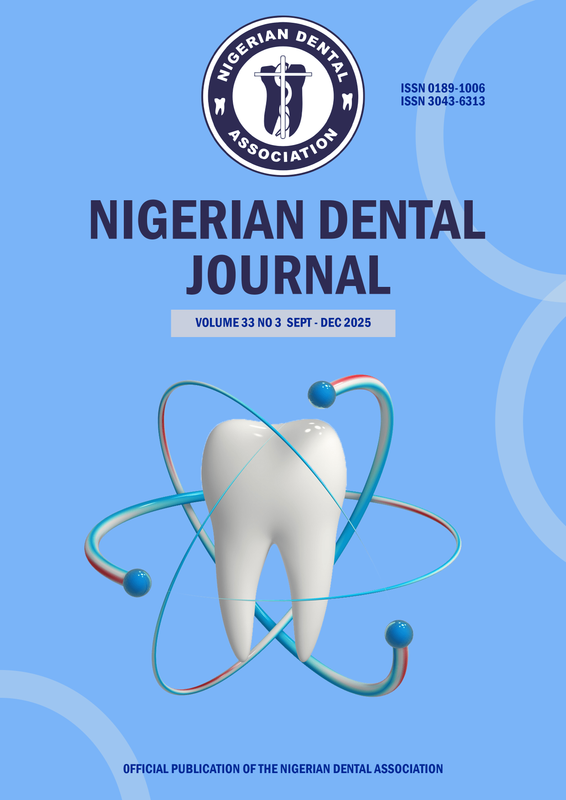Comparative Efficacy of Biodentine® and Calcium Hydroxide in Pulp Capping Treatment
BIODENTINE® AND CALCIUM HYDROXIDE IN PULP CAPPING
DOI:
https://doi.org/10.61172/nt6p6y21Keywords:
Deep caries, Indirect pulp capping, Biodentine®, Calcium hydroxideAbstract
Background: This study is focused on — Assessing Biodentine and Calcium hydroxide in indirect pulp capping procedures. Various materials have been used in indirect pulp capping but this comparative study may help appreciate which material produces better results: Biodentine or Calcium hydroxide.
Objective: To compare treatment outcomes post indirect pulp capping treatment using Biodentine® and Calcium hydroxide (Ca(OH)2) .
Materials and Methods: A blinded, randomized clinical control trial involving 50 consenting subjects, comparing Biodentine® (test) and Ca(OH)2 (control). Cavity preparation was done and the cavity was dressed with either Biodentine® or Ca(OH)2 and then restored with Glass ionomer cement. The subjects’ teeth were later examined clinically and radiographically at 3, 6, and 9 months post treatment. The indicators of clinical success were absence of pain, swellings, sinus, fistula, abscess, mobility, tenderness to percussion, normal response to electric pulp tester, and Endo-ice cold test. The indicator of radiographic success was absence of periapical pathosis. The probability level of p<0.05 was considered significant.
Results: The success rate at three months was 100% for both groups; at six months, it was 92% for both groups and at nine months, 92% of subjects were successful in the Biodentine® group while the Ca(OH)2 group recorded 88% which was statistically insignificant (P=0.74).
Conclusion: Biodentine® and Calcium hydroxide have shown comparable effectiveness in improving treatment outcomes, thus, contributing to the longevity of the teeth, and the period of optimum efficaciousness of the pulp capping materials in this study was three months.
Downloads
References
Alex G. Direct and indirect pulp capping: A brief history, material innovations, and clinical case report. Compend Contin Educ Dent. 2018;39(3):182–9.
Bjorndal L, Simon S, Tomson PL, Duncan HF. Management of deep caries and the exposed pulp. Int Endod J. 2019;52:949–73.
Schwendicke F, Brouwer F, Schwendicke A, Paris S. Different materials for direct pulp capping : systematic review and meta-analysis and trial sequential analysis. Clin Oral Invest. 2016;20:1121–32.
Vural UK, Kiremitçi A, Gökalp S. Clinical assessment of mineral trioxide aggregate in the treatment of deep carious lesions. Niger J Clin Pract. 2017;20(5):600–5.
Oz F, Bolay S, Bayazit E, Bicer C, Isikhan S. Long term survival of different deep dentin caries treatments: A 5-year clinical study. Niger J Clin Pract. 2019;22:117–24.
Carti O, Oznurhanle F. Evaluation and comparison of mineral trioxide aggregate and Biodentine in primary tooth pulpotomy: Clinical and radiographic study. Niger J Clin Pract. 2017;20:1604–9.
Hashem D, Manocci F, Patel S, Manoharan A, Watson T, Banerjee A. Evaluation of the efficacy of calcium silicate vs . glass ionomer cement indirect pulp capping and restoration assessment criteria : randomised controlled clinical trial — 2-year results. Clin Oral Investig. 2019;23:1931–9.
Gurcan AT, Seymen F. Clinical and radiographic evaluation of indirect pulp capping with three different materials: A 2-year follow-up study. Eur J Paediatr Dent. 2019;20(2):105–10.
Petrou MA, Alhamoui FA, Welk A, Altarabulsi MB, Alkilzy M, Splieth CH. A randomized clinical trial on the use of medical portland cement, MTA and calcium hydroxide in indirect pulp treatment. Clin Oral Investig. 2014;18(5):1383–9.
Baskaran S, Ahamed S, Narayana S, Bhavani S, Rajaraman G. A randomized controlled study of the use of mineral trioxide aggregate angelus (white) and biodentine as pulp capping materials. Endodontology. 2018;30(1):69–75.
Jalan AL, Warhadpande MM, Dakshindas DM. A comparison of human dental pulp response to calcium hydroxide and Biodentine as direct pulp-capping agents. J Conserv Dent. 2020;20(2):129–33.
Arshad E, Gyanendra K, Dhillon JK. Comparative evaluation of clinical outcome of indirect pulp treatment with calcium hydroxide, calcium silicate and Er,Cr:YSGG laser in permanent molars. Laser Ther. 2019;28(2):123–30.
Boddeda KR, Rani CR, Vanga NR, Chandrabhatla SK. Comparative evaluation of biodentine, 2% chlorhexidine with RMGIC and calcium hydroxide as indirect pulp capping materials in primary molars: An in vivo study. J Indian Soc Pedod Prev Den. 2019;37(1):60–6.
Tran X, Chaussain C, Willig C, Gorin C, Baroukh B, Pellat B, et al. Effect of a calcium-silicate-based restorative cement on pulp repair. J Dent Res. 2012;91(12):1166–71.
Goldberg M, Farges J, Lacerda-Pinheiro S. Inflammatory and immunological aspects of dental pulp repair. Pharma Res. 2008;58(2):137–47.
Camilleri J. Characterization of hydration products of mineral trioxide aggregate. Int Endod J. 2008;41(5):408–17.
Aksoy MK, Oz FT, Orhan K. Evaluation of calcium (Ca 2+) and hydroxide (OH −) ion diffusion rates of indirect pulp capping materials. Int J Artif Organis. 2017;40(11):641–6.
Malkondu Ö, Kazandaǧ MK, Kazazoǧlu E. A review on biodentine, a contemporary dentine replacement and repair material. BioMed Res Int. 2014;1–10.
Nowicka A, Wilk G, Lipski M. Tomographic evaluation of reparative dentin formation after direct pulp capping with Ca( OH )2, MTA, Biodentine and dentin bonding system in human teeth. J Endod. 2015;41(8):1234–40.
About I. Biodentine: From biochemical and bioactive properties to clinical applications. G Ital Endod. 2016;30:81–8.
Simon S, Cooper P, Smith A, Picard B, Naulin Ifi C, Berdal A. Evaluation of a new laboratory model for pulp healing: Preliminary study. Int Endod J. 2008;41(9):781–90.
Pitts NB, Ismail AI, Martignon S, Ekstrand K, Douglas G V, Longbottom C. ICCMS TM Guide for practitioners and educators. ICDAS Found. 2014;1–84.
Clifton L, Birks J, Clifton DA. Comparing different ways of calculating sample size for two independent means : A worked example. Contemp Clin Trials Comm. 2019;13:1–7.
Benoist FL, Ndiaye FG, Kane AW, Benoist HM, Farge P. Evaluation of mineral trioxide aggregate ( MTA ) versus calcium hydroxide cement ( Dycal ) in the formation of a dentine bridge : a randomised controlled trial. Int Dent J. 2012;62:33–9.
Israel GD. Determining sample size. Inst Food Agric Sci. 2003;PEOD6:1–5.
Sultana R, Hossain M, Alam S. Evaluation of clinical and radiological outcomes of mineral trioxide aggregate and calcium hydroxide as indirect pulp capping agents in the treatment of deep carious lesion of permanent teeth. Bangabandhu Sheikh Mujib Med Univ J. 2016;9:140–5.
Ford TRP, Patel S. Technical equipment for assessment of dental pulp status. Endod Top. 2004;7:2–13.
Ajayi DM, Abiodun-Solanke I, Gbadebo SO. A 5-year retrospective study of rampant dental caries among adult patients in a Nigerian teaching hospital. Indian J Dent Res. 2015;26:267–70.
Bakare TI, Okoturo E, Obisesan B, Oyapero A. Patients attitudes toward screening for medical conditions in a dental clinic at the Lagos State University Teaching Hospital Ikeja. Int J Heal Allied Sci. 2018;7:150–8.
Lipski M, Nowicka A, Kot K, Stefanska LP, Jankowicz IW, Borkowski L et al. Factors affecting the outcomes of direct pulp capping using Biodentine. Clin Oral Investig. 2018;22:2021–9.
Jafarzadeh H, Abbott P V. Review of pulp sensibility tests . Part I : general information and thermal tests. Int Endod J. 2010;43:738–62.
Stafuzza CT, Vitor LLR, Rios D, Cruvinel T, Neto NL, Sakai VT et al. A randomized clinical trial of cavity liners after selective caries removal : one-year follow-up. J Appl Oral Sci. 2019;27:1–7.
Kusumvalli S, Diwan A, Pasha S, Devale M, Chowdhary C, Saikia P. Clinical evaluation of biodentine: Its efficacy in the management of deep dental caries. Indian J Dent Res. 2019;30(2):191–5.
Caruso S, Dinoi T, Marzo G, Campanella V, Giuca MR, Gatto R, et al. Clinical and radiographic evaluation of biodentine versus calcium hydroxide in primary teeth pulpotomies: A retrospective study. BMC Oral Health. 2018;18(1):1–7.
Udoye CI, Jafarzadeh H, Okechi UC, Aguwa EN. Appropriate electrode placement site for electric pulp testing of anterior teeth in Nigerian adults : a clinical study. J Oral Sci. 2010;52(2):287–92.
Villa-chávez CE, Patiño-marín N, Loyola-rodriguez JP, Zavala-Alonso N V, Martínez-Castañón GA, Medina-Solis CE. Predictive values of thermal and electrical dental pulp tests : A clinical study. J Endod. 2013;39:965–9.
Hashem D, Mannocci F, Patel S, Manoharan A, Brown JE, Watson TF, et al. Clinical and radiographic assessment of the efficacy of calcium silicate indirect pulp capping : A randomized controlled clinical trial. J Dent Res. 2015;94(4):562–8.
Awawdeh L, Al-Qudah A, Hamouri H, Chakra RJ. Outcomes of vital pulp therapy using mineral trioxide aggregate or Biodentine: A Prospective randomized clinical trial. J Endod. 2018;44(11):1–7.
Youssef A, Emara R, Taher MM, Al-Allal FA, Almaiki M, Almasri MA et al. Effects of mineral trioxide aggregate, calcium hydroxide, biodentine and endogain on osteogenesis, odontogenesis, angiogenesis and cell viability of dental pulp stem cells. BMC Oral Health. 2019;19(133):1–9.
Kiranmayi G, Hussainy N, Lavanya A, Swapna S. Clinical performance of mineral trioxide aggregate versus calcium hydroxide as indirect pulp-capping agents in permanent teeth: A systematic review and meta-analysis. J Int Oral Heal. 2019;11(5):235.
Akhlaghi N, Khademi A. Outcomes of vital pulp therapy in permanent teeth with different medicaments based on review of the literature. Dent Res J. 2015;12(5):406–17.
Downloads
Published
Issue
Section
License
Copyright (c) 2024 Frances Oluchukwu OBURO, Adenike Ololade AWOTILE, Ilemobade Cyril ADEGBULUGBE, Lilian Lami ENONE, Afolabi OYAPERO

This work is licensed under a Creative Commons Attribution 4.0 International License.
Open Access Statement
- We became fully Open Access since January 2023.
- Our new and archived materials are available free of charge on open basis and under a Creative Commons license as stated below.
Copyright statement
Copyright © 1999 The authors. This work, Nigerian Dental Journal by Nigerian Dental Association is licensed under Creative Commons Attribution 4.0 International License.


